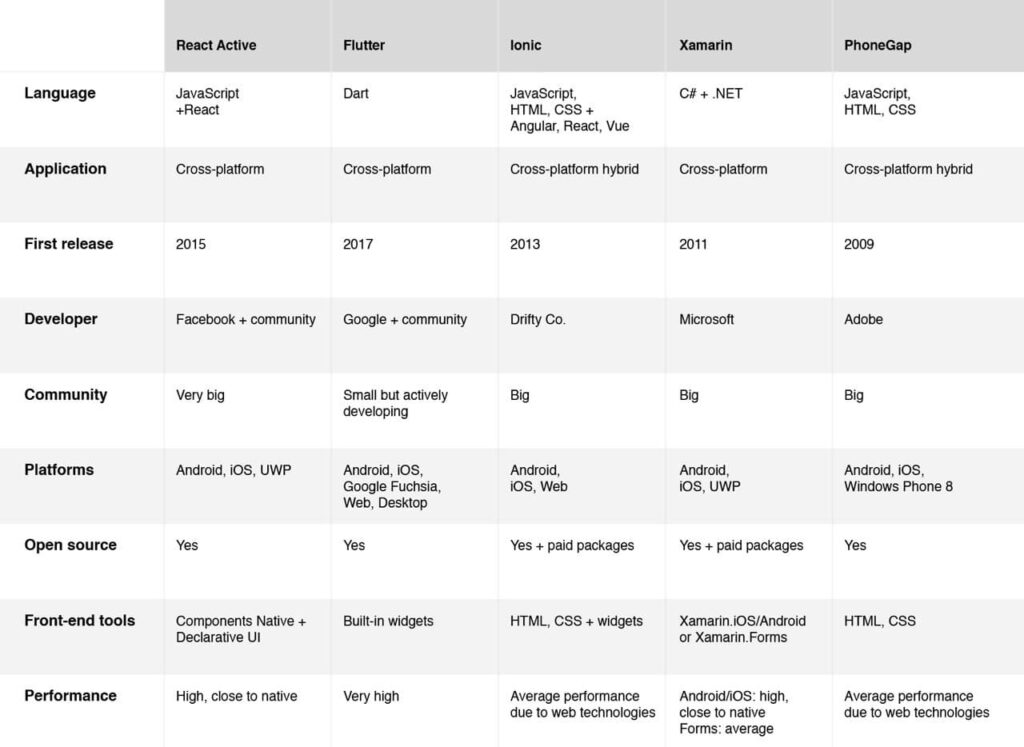The mobile application market has been around for over a decade and never ceases to grow. The demand for the development and creation of mobile applications from companies and young startups is constantly growing and it still significantly exceeds the supply, which leads to a constant rise in development costs. One of the solutions to speed up the development process is cross-platform development, when the same program code is used on all platforms.
But what is cross-platform development and how it differs from a native? Under native development experts involve the use of native software, whether it is Objective-C, and Swift for iOS or Java and Kotlin for Android, and other mobile operating system tools. In cross-platform development, specialized languages or frameworks are taken into account, with which you can create applications that work with multiple mobile operating systems.In our company, for the past two years, we have been actively working with the cross-platform Flutter – SDK.
The advantages of native applications
- response and speed of the application. The app responds to touch instantly with virtually no delay in scrolls, animation, receiving and outputting data, but does not always work correctly with the cross-platform development;
- clean and easy access to the functions, sensors. For the expert in the development will not be difficult to understand in working with geolocation, push notifications, video and photo shooting by the camera, sound, accelerometer and other sensors;
- interface native to the chosen platform. Native applications usually operate on “platform” interface elements: navigation, menus, forms and other design elements are taken from the OS.
Disadvantages of native applications exist, but the main thing is the high cost of development and support, including the fact that each platform should write your code that you want to attract more developers, and for developing cross-platform Flutter may use the services of a specialist.

In contrast to the native cross-platform applications written for multiple platforms in the same language. How can such a code work on different devices? There are two approaches to this.
The first lies in the fact that during the preparation of the application to the publication it is converted into native to a particular platform via transpilera. In simple words – a cross-platform programming language “translation” on the other.
The second is that a certain wrapper is added to the resulting code, which, working already on the device, translates calls from the non-native code to the native functions of the system.
Benefits of cross-platform applications
- speed of development. Since the amount of code is much less, and the cost of work is reduced;
- one source code saves you the trouble of hiring multiple developers for each platform.
The main disadvantages
- non-native interface or, at least, the need to work with the interface of each platform separately. Each system requirements for its design elements and sometimes they are mutually exclusive. In the development of this must be considered;
- problems in the implementation of complex functions due to bugs development frameworks themselves. The cross-platform environment only translates requests to the system and the interface, and therefore at this stage both difficulties in understanding and the occurrence of errors within the framework itself are possible;
- speed. Since the cross-platform environment is an “add-on” over the main code, there are delays in working out user actions and displaying the results.
To date, there are many good cross-platform technologies that allow you to create high-quality mobile applications. Next, we’ll look at a comparison of the most popular cross-platform development frameworks.

Based on these characteristics, you can choose a development framework that is convenient for you and suitable for a specific application.
Conclusions
The choice of framework for cross-platform development is quite extensive, and it is difficult for a business owner to choose the right solution. To make your choice easier, you can use the following guidelines:
- Cordova and HTML5 are great if you want to build an app quickly that works on all devices. But the functionality will be limited, as well as the appearance, but this will allow you to quickly launch the project, test the chosen niche, and understand whether it is worth investing in developing a more functional application.
- You need to create high-quality applications for business, which will last more than one year and will run without errors? Then it’s better to use native development. But just in case, if the idea of standing and having the means to implement multiple sets of code for each mobile OS.
- PWA is used to create beautiful, colorful, but not very functional applications. But if it is not a necessary task to implement complex functions, the PWA – the perfect solution for a quick and inexpensive creation of cross-platform mobile applications.
- Xamarin is for those who are much more important than the functionality of the beauty interface. For example, to create a corporate program or analysis applications.
- React Native helps you create a fast and functional application. But the feature set is limited, so if you want to add a lot of possible applications, this framework will not work, but for applications, business cards – completely.
- With Flutter it is possible to realize a beautiful and functional application, but its weight is quite large. If this is not a problem for you, then this framework is a great solution for visual as well as for the technical component.
In any case, a specialist will help you find the right solution for cross-platform mobile app development. Only after the discussion of the project and clarification of all tasks will be to offer the most effective solution for development. We have many interesting projects that we have realized in the Flutter. Still have questions? Contact us and we will help you get the answers!
By the way with all the mobile apps advantages for business you can read our updated article!




